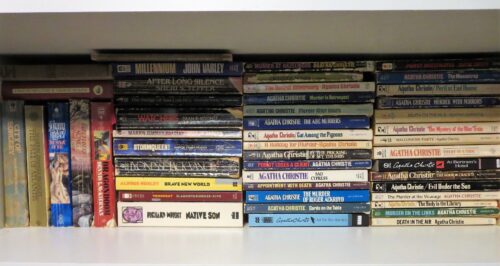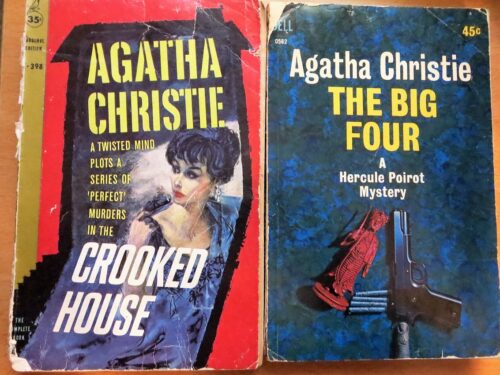Previously in How I Met My Book I told you about some of my hand-me-downs, unexpected loaners, and permanently “borrowed” books. This time I want to tell you about my treasure trove of old paperbacks. I keep most of them behind another row of books, not because I’m trying to hide them, but because that’s where they fit. My husband often comments on my ability to pack books into boxes and onto shelves with very little wasted space. It would seem an odd gift for someone like myself, who typically struggles with spacial puzzles and tasks. That’s because it’s not a gift, but rather a skill developed over a lifetime of having more books than shelves. When you have inadequate storage space for your books, you learn to organize them not by genre, author, color, or any other such nonsense, but rather by size. You squeeze them in, layer them up, and stack them horizontally, even diagonally, if need be. You learn to use every square inch of shelving.

Though I don’t hide these books deliberately, some would say I have reason to. They’re a shabby lot, mostly genre fiction. Many of them look and smell very old, pages all brown and spotty, covers crumbling, spines cracking. Some of them are almost bizarre in that the prices on their covers no longer resemble normal prices.

As a general rule, I prefer hardcovers to paperbacks. Paperbacks are great, though, when you don’t have a lot of room, and they’re ideal for a collection of Agatha Christie novels. She wrote a lot of books, and I own a lot of them. I wouldn’t be able to keep such a large collection if they were all hardcover. But, the reason that I prefer hardcovers is that they’re more durable, and indeed, some of these paperbacks aren’t holding up so well. The pages of Crooked House, for example, are falling out. I won’t be able to read the book again unless I can find a way to repair it.
As to how I met these books, I can’t tell you where each one came from, but a lot of them came from tag sales. I used to love shopping for books at tag sales. When I was a kid, books were so much more difficult to get. New books were too pricey. Used books were often hard to find, and though they were cheaper, they weren’t cheap. Tag sale books were wonderfully affordable, though, and much more readily available. During the summer it seemed like someone was always having a tag sale somewhere nearby.
Tag sale books were a great deal of fun to look through, if a little scary sometimes. The trouble with books is that they are so common and cluttery, not to mention hard to store, that they end up everywhere, including places where they don’t really belong, like basements. Wherever books go, they are bound to absorb elements of their surroundings–food, water, dust, mold, insects, perfume, cigarette smoke, and other alarming smells–and while it is interesting, this way in which books incorporate their history, it is not always pleasant. But, for those intrepid souls with the spirit of treasure seeking, and greedy for new reading material, nothing was more fun than digging into a box of dusty old books. You just never knew what treasure you might find.
I have read all of the books in my hidden trove, and will probably read most of them again. But I think the reason I love these books is that, more than anything else, they speak of that time in my life when all the books were “new to me” and it was such a joy just to find them and be able to bring them home with me. Now I can afford to buy new books, and I can buy them from all over the world, at any time of day or night. And while that is fantastic in its own way, it does take away a tiny bit of the magic of ownership. We love most those things that we have had to struggle for. Some of my books are treasures, not because of any intrinsic value, but simply because I found them while hunting for treasure.
